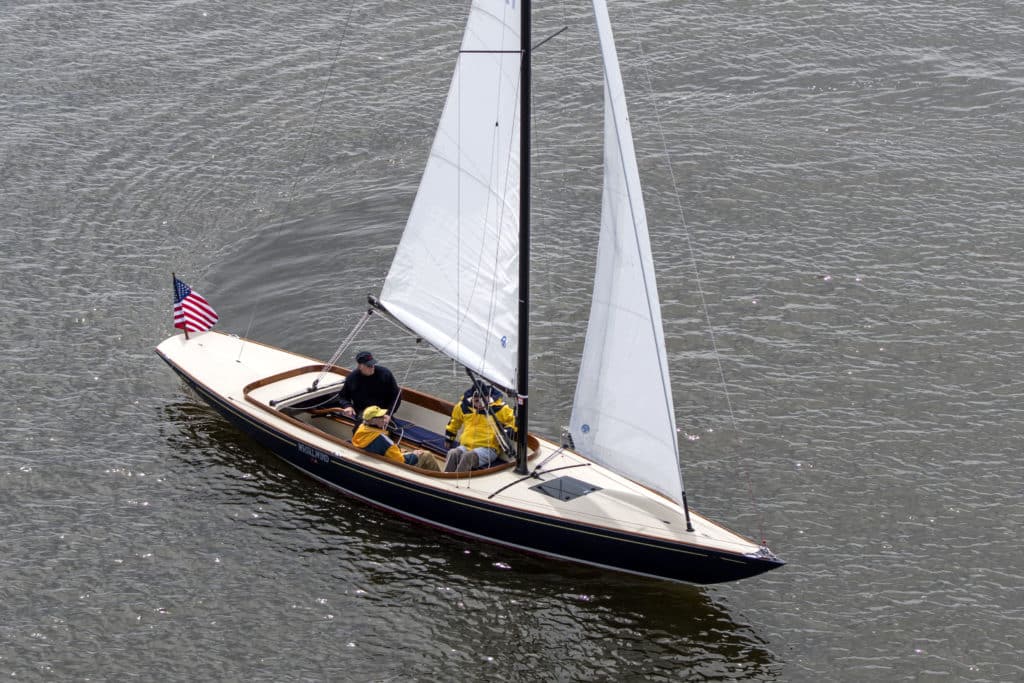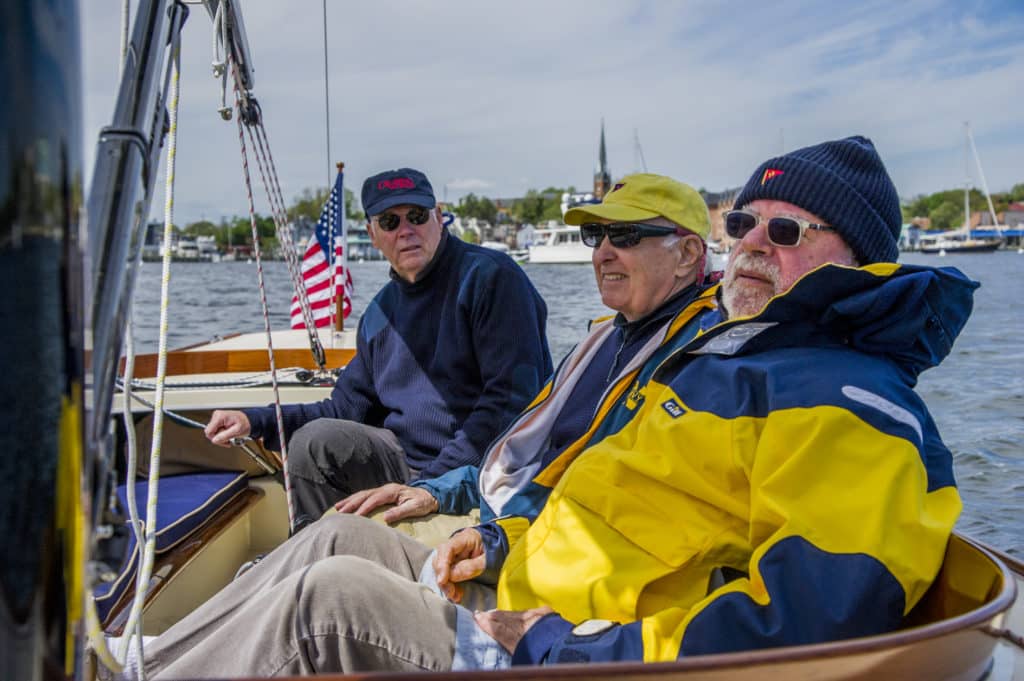
When the Spa Creek Bridge opens, near my home in Annapolis, Maryland, I always have this nice feeling of anticipation that a good day on the water is ahead. Within minutes, the crowded harbor falls behind while the immense Chesapeake Bay invites a sail in any direction. After spending 60 years racing boats of all sizes, and cruising to the extreme ends of the earth, I have rediscovered how much fun it is to go daysailing.
Every reward one might hope to experience on a long voyage can take place on a simple daysail. Two years ago, I acquired a C.W. Hood 32 sloop with the single purpose of taking family and friends sailing around Annapolis, and sometimes beyond. The boat has everything I was looking for. It’s easy to sail singlehanded, has a comfortable and safe cockpit that can accommodate six adults, has classic lines and is fun to sail in all weather conditions. As I did my research, I decided to include an electric motor, a head and an easy setup for a downwind sail.
Anyone aspiring to become a sailboat owner should spend time defining how the boat will actually be used, and look for that perfect one to achieve this goal. So with my new pride and joy at the ready, I have been sailing regularly. It’s a simple concept, but it takes considerable planning to make a daysail special for everyone. Every session has a different personality depending on the weather, crew list and destination.
If you wait for the perfect weather, it might be a long time before you go sailing. I try to work with a schedule, and take the weather as it comes. On one Sunday, I invited two longtime friends for a full-day sail. The night before was ugly, with thunderstorms and howling winds. By morning, the sky was still gloomy, yet both guests showed up right on time. Off we went. The voyage (I like that term for a daysail) started with a brief overview of the sailing plan and how to use the engine and operate the head. The conversation began with the news of the day and quickly changed to houses on the shore that were undergoing renovations. We called the Spa Creek Bridge operator to request an opening, waved a thank you as we passed and set the sails. The first warmup for our voyage was a short sprint up an inlet that leads into downtown Annapolis. Anyone who has ever attended the famous U.S. Sailboat Show will be familiar with Ego Alley. The inlet is well-named because you get to show off your boat to the adoring crowd on shore.
On the way out of the harbor, we passed a college regatta. A coach on a nearby patrol boat told us it was the Women’s Middle Atlantic Championship. The racing looked intense. With a brisk northerly blowing, we threw the wind over our shoulder and headed out toward Chesapeake Bay. This is the largest estuary in the United States, measuring 195 miles long and anywhere from 3 to 35 miles wide. There are 5,600 miles of shoreline, with an average depth of 21 feet. The bay was formed at the end of the last ice age, and was explored and mapped for England by Capt. John Smith in 1608, although indigenous people have lived along the bay for many centuries. You can spend a lifetime plying these waters and always find something new. My first race on the Chesapeake was in the early 1960s; I am happy to report that the water looks considerably cleaner today.
I like passing close to channel buoys to study the current and tune up my steering. In no time, we were in the bay. I am always amazed by how boats separate on open water. Inevitably, we will sail near another boat. Instinct takes over, and I try to sail past. Even friends who are new to sailing quickly get into the routine and watch to see if we make progress in our quest to gain the lead. I am always studying the wind for shifts and puffs, and trying to make maximum gain.
Crewmembers are happy when given a job on a boat. My first move is to pass over the helm. I have yet to witness anyone decline the chance to steer. I have learned that less-experienced sailors are usually receptive to a little bit of coaching, but I have to be careful not to overcoach or the fun will quickly fade.
Depending on the direction and strength of the wind, I set a course for a specific destination. On this day, we sailed toward the expansive Bay Bridge, a few miles north. I am happier to sail under a bridge than to drive across. Even though the Bay Bridge is 200 feet above the water, I look up to make sure the mast will clear. From the boat, it feels closer. The boat features a low freeboard that naturally connects you to the water. Even with the low freeboard, the C.W. Hood 32 rides gracefully over choppy waves. It is a dry boat.

I named my Hood 32 Whirlwind in honor of L. Francis Herreshoff, who designed a J-class yacht named Whirlwind for the 1930 America’s Cup trials. The double-ended yacht was a pretty sight but did not win many races. I liked the fact that the crew never gave up. My Whirlwind was designed and built by Chris Hood in Marblehead, Massachusetts. The build took place in a shed that was constructed in 1897 — certainly a nice pedigree in a historic sailing town. Whirlwind features a large, open cockpit. Chris arranged the seating perfectly for sailing. The coaming is the right angle no matter what angle of heel you’re on. There is just enough clever storage space under the seats. There is no need to hike out. A 4-foot-deep Scheel keel gives the boat good stability. All sail-trimming lines are led to a console near the tiller for singlehanded sailing. Whirlwind is easy to maintain and to keep clean and polished. Guests feel more comfortable on a well-founded yacht. Keeping varnish up and all equipment in order makes for a better experience.
My sailing guests range from first-time sailors to longtime veterans. The hardcore racers appreciate the change of pace of daysailing. There is never any pressure. I find that you can have good discussions with people on the water. Sometimes I use the boat to take out political leaders and slowly work a conversation toward an important issue. My commentary is usually better received on the water.
As our daysail with my two friends continued, the conversation moved toward sailing. One asked about my favorite daysails over the years. It made me think back to a day in July 1977 aboard the 12-Meter Courageous. Our stablemate, Independence, was forced to return to the dock for a repair. One of our crew, Richie Boyd, suggested we sail out to Block Island, which is 23 miles south of Newport, Rhode Island. Our skipper, Ted Turner, didn’t miss a beat and said, “Let’s go.” A few hours later, we anchored in the harbor, got a ride ashore and had lunch at an open-air lobster house. We even mailed a postcard to our syndicate head, Lee Loomis. I never found out if he got the humor.
Another memorable sail took place during one of my expeditions to Antarctica. We woke up to a beautiful, sunny 20-knot day, with the temperature in the 40s. We spent the afternoon simply sailing around the icebergs. One especially large berg rolled a few minutes after we passed by. We gave the bergs a wide margin after that near-catastrophe.
On a rare Saturday with nothing scheduled, my wife, Janice, and I took Whirlwind for an afternoon sail. The breeze was forecast to build throughout the day. My plan was to sail northwest up the 14-mile-long Severn River and then set the spinnaker for a fast ride home in the strong breeze. When we arrived at the mouth of the Severn, the U.S. Naval Academy had closed the river to boat traffic for the afternoon in favor of a Safety at Sea seminar that included a helicopter-rescue demonstration by the U.S. Coast Guard. I headed downwind out into the bay. There were a few bulk carriers anchored across the bay, and we set course to round the ships and sail home. It was a nice ride in 18 knots. No sooner had we turned upwind, a front blasted in from the north. It was gusting over 35 knots! Fortunately, we had good foul-weather gear, life jackets and boots on. I played the mainsheet on each blast to keep the boat from overheeling. A few other boats took their sails down and went in under power. Sailing seemed safer, and we pressed on.
Conversation was sparse, but at one point, Janice asked where I would like my ashes spread when the day came. I hoped the heavy wind did not inspire that question, but I had an answer ready: “Good Luck Point, on Barnegat Bay.” This desolate, savanna-like point of land separates Toms River from Barnegat Bay. During my teenage years, I would sail my Penguin with one of my friends out the river into the bay. The afternoon thermal breeze was usually 15 to 18 knots. It felt so exciting to see no land on the horizon and choppy whitecaps ahead. I sailed for a good hour or more and then headed downwind for some surfing. I never capsized on those late-day sails. Thinking back, those sails were some of the best of my career. At the time, I rarely thought about what might be over the horizon in the years ahead. I suppose when you’re young, thoughts like that don’t extend too far in the future. But now, as 70 years of age looms on my horizon, I know the answer to the question about why I like to sail, be it during a race, offshore or a jaunt around the harbor.
What other sport can you do for an entire lifetime? Is there another activity that connects the generations like sailing? It is such a joy to take our grandchildren sailing. Through their eyes I get to see everything for the first time. Thanks to this sport, I have sailed off every continent and explored places I could never have imagined from land. Birds, fish and all kinds of sea life connect sailors with the environment and help them appreciate our planet. Time on the water passes swiftly. I am ready to set sail again as soon as I can.
– – –
CW editor at large Gary Jobson is an America’s Cup-winning tactician and longtime chairman of the Leukemia Cup Regatta.








